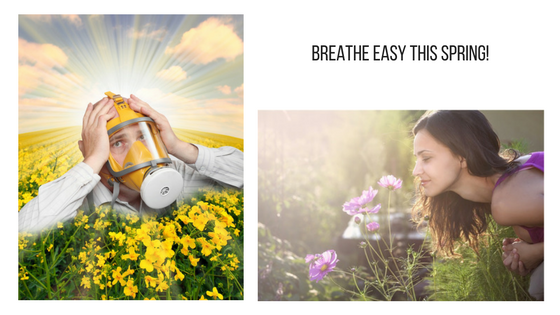Many of us are celebrating the return of warmer weather. For some though the last thing they want to do is gambol through the grassy, flower-filled meadow. Hay fever high alert! Cue itchy, red, puffy eyes, sniffles, endless sneezing, sinus headaches and generally feeling miserable. While these symptoms may not seem particularly life threatening they do cause fatigue, irritability, insomnia and reduced memory and concentration. Productivity plummets and so does your overall enjoyment of life1.
What’s going on?
Hay fever is classified as a Type 1 hypersensitivity reaction. The symptoms are triggered when pollen from the particular offending plant is inhaled. Often grasses are the culprits. When people with atopic immune systems (predisposed to asthma, eczema, headaches) are exposed to pollen (allergen) a series of immune reactions occurs. These result in the formation of IgE antibodies that bind to two types of white blood cells known as mast cells and basophils. These cells are abundant in the airways. On the next exposure to the allergen these cells release histamine granules. Histamine is responsible for the itching, sneezing, inflammation and excess mucus that pours out your nose 2.
If you’re not keen on using anti-histamines, decongestants and nasal corticosteroid sprays what other options do you have?
Avoid the offender or reduce your exposure?
This is going to have variable success as grass pollens are carried on the wind. There is evidence that seasonal allergy sufferers improve when they relocate to higher altitudes of live by the beach 3. However, if a tree or sea change is not practical for you at the moment here’s a plan B.
A naturopathic treatment approach to hay fever has 3 steps.
-
Relieve the symptoms so you feel better in the short term
-
Reduce the severity of hay fever by making the immune system stronger
-
Rebalance the immune system to reduce atopy and allergic responses.
Relieve
Quercetin
Quercetin is a bioflavonoid that is found in many fruits and vegetables but is most abundant in apples, onions and black tea.
It inhibits enzymes that cause inflammation and prevents mast cells and basophils from releasing histamine 4. This makes it beneficial in reducing the hay fever symptoms of runny nose watery eyes, hives and swelling of face and lips 5.
Quercetin supplements can change the metabolism of certain drugs. If you are taking prescription medication please consult with a qualified health care professional to see if it’s right for you.
Vitamin C & Zinc
Vitamin C & zinc are core nutrients for healthy immunity. Adequate vitamin C and zinc makes it harder for mast cells and basophils less to release histamine 6.
Eyebright (Euphrasia officinalis)
This herb contains aucubin, which decreases tissue inflammation. It is also reduces the formation of mucus reducing the runny nose and blocked sinuses3.
Eyebright can be taken as a tea or tincture and also used topically (diluted) as an eyebath to improve symptoms of redness and itchiness in the eyes. If using the tea topically on the eyes make sure you strain it well to avoid getting plant particles in your eye.
Stinging Nettle Leaf (Urtica dioica folia)
The Latin name of this plant means “I burn”. Anyone who has brushed against a stinging nettle inadvertently will know the truth of this!! The hairs contain formic acid and histamine and these are responsible for the sting and resulting skin irritation 7. Now, it may seem counterintuitive to use a plant that contains histamine for seasonal allergies but once the hairs on the plants are neutralized by heat or freeze drying nettle leaf becomes one of the best herbs to treat all kinds of allergies.
In terms of hay fever it has some very specific effects that make it useful. It blocks the histamine receptor on cells meaning histamine is effectively neutralized and it also makes the mast cells and basophils less likely to release histamine.
Nettle is effective as a tea. You’ll need to make it up to 15g nettle leaf to 1 litre water. Use within 24 hours.
Freeze-dried capsules and tinctures are also available..
Chamomile (Matricaria recutita)
Chamomile may be known as “mother of the gut” but it’s also very handy to help with hay fever symptoms. Like nettle it reduces histamine and helps to stabilise mast cells. Studies have shown it to have particular benefit in reducing itchiness 9. Chamomile can be used as a tea, tincture or a steam inhalation to help clear the sinuses.
Reduce
This is all about ensuring your immune system is fighting fit. We want to especially target the mucous membranes. These watery membranes line your nose, sinus and airways. They are packed full of the mast cells and basophils. Think of it as a fortress. If your mucus wall is healthy then the allergen won’t be able to come into physical contact with the mast cells and create havoc.
How can you get mucous membranes of steel?
Diet
Eliminate or go easy on the foods that weaken these membranes. Top of the list are dairy products closely followed by processed wheat, sugar and salt. These foods can trigger the production of excess mucus that may overwhelm your body’s capacity to clear it 3. If you really get bowled over by hay fever consider eliminating them entirely for 6 weeks prior and during hay fever season.
A diet with a wide variety of fruits, vegetables, moderate amount of protein and some healthy fats provides the necessary nutrients for mucous membrane, immune and general health.
Specific nutrients for hay fever
Vitamin A or specifically retinol the active form found in meat and cod liver oil is needed for the secretion of mucus. People deficient in Vitamin A tend to get more respiratory tract infections 10. Seek the advice of a health care professional before supplementing if you are pregnant or have liver disease.
Zinc helps Vitamin A to be released from the liver and go to where it is needed. It also helps keep the junctions between your mucous membranes tight keeping your fortress strong 11.
Vitamin C helps reduce inflammation and supports both zinc and Vitamin A to do their jobs well.
Eyebright
In addition to symptom relief Eyebright can also be taken prior to allergy season to strengthen the mucous membranes of the sinus and upper respiratory tract and help clear excess mucus.
Hydration
As mucus is comprised predominantly of water it follows that to have healthy mucous membranes you will need to be well hydrated with plenty of filtered water to provide the raw materials.
General immune support for hay fever
The herbs Echinacea and Astragalus will help to build a strong and robust immune system.
Probiotics containing strains Lactobacillus rhamnosus GG, Lactobacillus acidophilus NCFM and Bifidobacterium lactis have been shown to improve upper respiratory tract immunity 12.
Rebalance
Atopy is a genetic predisposition to suffer from allergic disease including hay fever, asthma and eczema. The immune system is a complex interplay of immune cells and chemicals. In a person without atopy immune responses shift back and forward as required depending on the type of response required. In atopic individuals the immune system gets locked into one mode and the balance is lost 13. There are certain nutrients and herbs that can help restore balance.
Quercetin
Quercetin decreases allergic tendencies by rebalancing the ratio of Th1 to Th2 cells. Excess Th2 cells are thought to be the main culprits in an unbalanced immune system.
Vitamin D
The “sunshine” vitamin is often lower in people who experience hay-fever 14. It’s a good idea to get this tested before supplementing in large amounts. Ensure you get regular safe sun exposure can also help. Here are some Australian guidelines. **
** If you have a history of skin cancer or melanoma please seek the advice of your medical professional.
Essential Fatty acids
Fish oil helps block excess inflammation and by doing so regulates the immune system 15. The most easily absorbable forms are found in oily fish such as salmon, mackerel, herring and sardines. Farmed fish contain much lower amounts so try to source wild caught fish.
Scutellaria baicalensis
This Chinese herb helps stabilise mast cells and has been shown to balance the production of Th1 and Th2 immune cells. It has a calming action on the nervous system making it a useful treatment for those people whose immunity is reduced by stress 16.
What are you waiting for? Relieve your symptoms, strengthen and rebalance your immune system so you too will fall in love with Spring!
- Roger A, Arcalá Campillo E, Torres MC, et al. Reduced work/academic performance and quality of life in patients with allergic rhinitis and impact of allergen immunotherapy. Allergy, Asthma Clin Immunol. 2016;12(1):40. doi:10.1186/s13223-016-0146-9.
- Leung AKC, Hon KE. Seasonal allergic rhinitis. Recent Pat Inflamm Allergy Drug Discov. 2008;2(3):175-185. http://www.ncbi.nlm.nih.gov/pubmed/19076007.
- Bone K, Mills S. Principles and Practice of Phytotherapy. 2nd ed. London: Churchill Livingstone; 2013.
- Hattori M, Mizuguchi H, Baba Y, et al. Quercetin inhibits transcriptional up-regulation of histamine H1 receptor via suppressing protein kinase C-δ/extracellular signal-regulated kinase/poly(ADP-ribose) polymerase-1 signaling pathway in HeLa cells. Int Immunopharmacol. 2013;15(2):232-239. doi:10.1016/j.intimp.2012.12.030.
- Hirano T, Kawai M, Arimitsu J, et al. Preventative effect of a flavonoid, enzymatically modified isoquercitrin on ocular symptoms of Japanese cedar pollinosis. Allergol Int. 2009;58(3):373-382. doi:10.2332/allergolint.08-OA-0070.
- Maintz L, Novak N. Histamine and histamine intolerance. Am J Clin Nutr. 2007;85(5):1185-1196. http://www.ncbi.nlm.nih.gov/pubmed/17490952. Accessed June 3, 2014.
- Ait Haj Said A, Otmani IS El, Derfoufi S, Benmoussa A. Highlights on nutritional and therapeutic value of stinging nettle (Urtica Dioica). Int J Pharm Pharm Sci. 2015;7(10):8-14.
- Upton R. Stinging nettles leaf (Urtica dioica L.): Extraordinary vegetable medicine. J Herb Med. 2013;3(1):9-38. doi:10.1016/j.hermed.2012.11.001.
- Chandrashekhar VM, Halagali KS, Nidavani RB, et al. Anti-allergic activity of German chamomile (Matricaria recutita L.) in mast cell mediated allergy model. J Ethnopharmacol. 2011;137(1):336-340. doi:10.1016/j.jep.2011.05.029.
- Amaral CT, Pontes NN, Maciel BLL, et al. Vitamin A deficiency alters airway resistance in children with acute upper respiratory infection. Pediatr Pulmonol. 2013;48(5):481-489. doi:10.1002/ppul.22621.
- Prasad AS. Zinc in Human Health: Effect of Zinc on Immune Cells. Mol Med. 2008;14:353-357. doi:10.2119/2008-00033.Prasad.
- Hawrelak J, Crittenden RG. Probiotics, prebiotics and synbiotics. J Complmentary Med. 2007;(6):28-35. www.ebscoehost.com. Accessed October 18, 2014.
- Bridgman K. A Systemic Approach to Respiratory Health. J Aust Tradit Soc. 2011;17(1):9-16. http://ehis.ebscohost.com.ezproxy.endeavour.edu.au:2048/eds/detail?sid=d09d5390-b302-4cbe-ab0b-9b416f81f937@sessionmgr15&vid=108&hid=116&bdata=JnNpdGU9ZWRzLWxpdmU=#db=awh&AN=64903636.
- Ozkara S, Keles E, Ilhan N, Gungor H, Kaygusuz I, Alpay HC. The relationship between Th1/Th2 balance and 1α,25-dihydroxyvitamin D₃ in patients with nasal polyposis. Eur Arch Otorhinolaryngol. 2012;269(12):2519-2524. doi:10.1007/s00405-012-1967-x.
- Calder PC. The relationship between the fatty acid composition of immune cells and their function. Prostaglandins Leukot Essent Fatty Acids. 2008;79(3-5):101-108. doi:10.1016/j.plefa.2008.09.016.
- Lago JHG, Toledo-Arruda AC, Mernak M, et al. Structure-activity association of flavonoids in lung diseases. Molecules. 2014;19(3):3570-3595. doi:10.3390/molecules19033570.

Need help with your immune system?
Norelle Hentschel is an experienced Naturopath with a clinic in Stones Corner, Brisbane who enjoys supporting her clients to reach their health goals.
Want more articles like this?
Receive a monthly digest of natural health information to help you become “health” sufficient!
PS. Your inbox real estate is precious, and we will never annoy you with sales pitches or share your details with anyone else. One email a month — that’s it.

